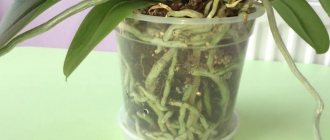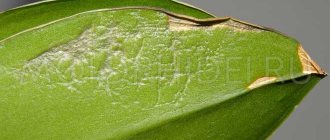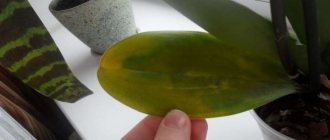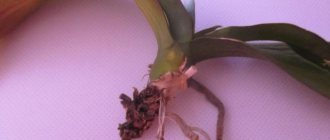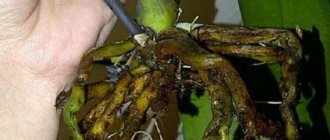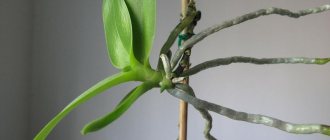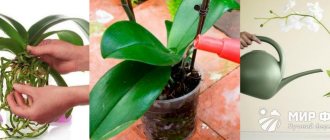The disease of a favorite flower, nurtured with such patience and care from a small sprout that arrived from a distant foreign country in a flask, is always a very big annoyance and a lot of trouble for the orchid grower. Black rot on an orchid is one of the most dangerous pathologies and can only be treated in the initial stages of the onset of the disease.
It is most often found on plants of the genus Cattleya and Paphiopedyllum, and 70% of diseased orchids are from newly arrived flowers that have traveled a long way from a foreign greenhouse to the buyer’s home. However, other types of orchids are not immune to this scourge; for example, black rot in the phalaenopsis orchid is also a common occurrence. Laelia, stangopea, and leliocattleya are also at risk.
Possible causes of blackening of roots
It is not difficult to determine the rotting of the roots: when compressed, water oozes out of them, the top layer is easily separated, revealing the thread-like middle. The occurrence of this condition of the roots can be due to a number of reasons.
Failure to follow plant care rules
For beginning orchid lovers, one of the reasons for root rot is mistakes made in caring for orchids.
Improper watering
- Excess moisture in the pot, or, more simply, overwatering. If there is too much moisture, air access to the roots is cut off. The process of photosynthesis stops, water remains in the velamen and does not enter the leaves. The substrate creates a favorable environment for the development of pathogens. The root system begins to rot.
- Stagnation of water in the leaf axils after sprinkling. If moisture evaporates quickly from the surface of the leaf plate, then it remains in the recesses of the sinuses for a long time. Over time, a putrefactive process develops in this place. In this case, the stem of the plant and along with it the nearby roots begin to rot first. It is almost impossible to save such a plant.
- Therefore, remove any remaining water from the leaf axils. Watering with very cold or chlorinated water will also result in root rot.
It is enough to follow simple watering rules and you can avoid the loss of a wonderful tropical specimen.
Temperature
Low room temperatures and very cold window sills can also lead to slow evaporation of moisture from the substrate. This, in turn, is stagnation of cold water in the roots. In such a situation, the onset of putrefactive processes is also inevitable.
During the cold season, it is necessary to remove orchids from windows. 20 minutes in a draft, and the orchid can lose all its leaves.
Insufficient lighting
Another good reason affecting the appearance of brown spots on the roots.
The force that draws water through the velamen cells higher to the leaves appears only under certain lighting conditions. If the lighting is insufficient, then the water remains in the roots. Over time, it becomes a source of decomposition of the cellular structure of tissues.
With sufficient lighting, the water constantly moves upward, thereby feeding the orchid, which thanks to this grows intensively.
Common types of rot
Common types of rot are present in large numbers. You need to know what exactly is affecting the plant for effective treatment. The main types of rot include the following, listed in the table. The reasons for the appearance of each type of rot and symptoms are also indicated there.
| Type of rot | Reasons for appearance | Symptoms and signs of the disease |
| Fusarium, or fusarium rot. Keep in mind that fusarium comes in two types: oxysporum (affects the roots and lower part of the stem) and moniliforme (affects the stem, leaves, flowers and peduncles). | The cause of the appearance is a fungal infection. It develops in an environment favorable to it (low soil temperature, excessive application of fertilizers with a high nitrogen content, excessive watering or too frequent spraying, damage by pests or improper replanting, high salinity or acidity of the soil, irregular drying of the substrate. | The first sign is the appearance of dusty spots with a purple tint. It is in them that spores begin to form (if there are other plants nearby, they will also get sick). The main symptoms include the appearance of areas of redness or yellowing, blackened and depressed areas (very similar in appearance to a burn), softening and darkening of the stem, and the spread of spores throughout all elements of the plant. |
| Wet bacterial rot. | The cause of its appearance is bacteria (they belong to the genera erwinia and gladioli). Their favorable environment is excessively warm and humid conditions (high temperature and humidity). A plant can become infected through water, substrate, from neighboring diseased plants, and also through the air (rare, but it does occur). | Keep in mind that rot affects different varieties of orchids differently. On cattleya, oncidium, epidendrum, spotting appears (it is yellow-brown, uneven and yellow), which gradually covers the entire leaf and changes its color to brown. On paphiopedilum, bacterial rot appears in the form of brown spots, which first affect the edges of the leaves, and then, moving along the veins, affect the entire area (the boundaries of the spot are always clear). Yellow-brown spots appear on phalaenopsis (as the disease progresses, the spots increase), which over time destroy the structure of the plant element, and a yellowish liquid is released from the spots. |
| Phytophthora and patium | The cause of the appearance is fungal pathogens. Their development occurs at high humidity and low temperature. A distinctive feature of the fungus is the high speed of movement of spores between plants through the air. The disease usually manifests itself within a range of one to ten days. | Late blight and patium manifest themselves in the same way, and the symptoms depend on the orchid variety. In phalaenopsis, the root system is first affected, then the stems and leaves are affected. Dark spots appear on the roots, which affect the root system right up to the leaf rosette if no action is taken. The leaves rot from the middle. Also, these types of diseases can manifest themselves in the form of wet spots that gradually turn yellow and black, as a result, rotting areas appear. |
| Black rot | This disease is one of the most common. The problem can be detected twelve hours after the lesion. The reasons for the appearance include constant overheating of the root system, excessive nitrogen content in the fertilizers used, increased humidity levels in the room where the flower grows, and the use of an excessively dense substrate. | First, young shoots are affected, on which slippery spots with a black coating appear. Orchids of the Paphiopedilum and Cattleya varieties are especially susceptible to the disease. |
| Gray rot | The reasons for the appearance include increased humidity levels, damp soil and cold air in the room where the flower grows. | The disease is indicated by dark spots that are covered with a gray dry coating. The plant quickly weakens and dies. |
| Brown rot | This is a bacterial type disease. Occurs when there is excessive humidity and low temperature. Other reasons include excessive watering, the use of low-quality or unsuitable substrate for the orchid. | First, the root system suffers. The roots darken and eventually begin to rot. Later, the problem spreads to the leaves, which acquire a brown tint. The varieties of orchids most susceptible to this disease are miltonia, cymbidium, and paphiopedilium. |
All of these types of rot are the most common. They are the ones that infect the plant in most cases. Next, we will analyze treatment methods that are rational to use in accordance with the type of rot (an example of a rotting plant in the photo).
How to fix the situation
Trying to help a sick orchid is always worth a try. To do this, it is necessary to carry out a number of measures aimed at saving the flower.
Root system revision
The orchid is removed from the pot, washed with warm water, dried and thoroughly examined.
Determine the degree of damage by identifying the roots to be removed.
Trimming the affected part
To cut off rotten roots you will need a scalpel, a sharp knife or a special orchid pruner. Any of these instruments must be disinfected. This is done using medical alcohol or flame.
Dead roots are cut back to living and undamaged tissue. It is advisable to do this in one movement of the scissors so that the cut is even.
Disinfection of cuts and roots
Without disinfecting the cuts, there is no point in starting root cleaning. Sections are immediately disinfected with any of the following drugs:
- cinnamon powder;
- crushed activated carbon;
- 3% hydrogen peroxide.
Any of the powders are carefully poured into the places where the rot has been cut off; for liquid preparations, a pipette or a regular syringe without a needle is used.
After the work, the orchid should be left without water for 10–14 days to dry and heal the wounds.
For extensive pruning of the root system, the remaining few healthy roots 3–5 cm long are sufficient.
Replacing the pot and substrate
An orchid with trimmed and dried root remains is placed in a small pot 6–8 cm in diameter and placed in a bright place without direct sunlight. The night temperature is not lowered, but remains at 20–25° C.
The substrate for such an orchid is mainly prepared independently. It includes:
- The bark is fine-grained;
- Expanded clay or sphagnum.
Attentive attention to the conditions of keeping the orchid
At the initial stage of development of root rot, treatment is successful in 95% of cases. A common mistake is to assume, by looking at the top green and healthy part of the orchid, that the roots are accordingly fine. It is necessary to inspect the plant periodically, completely and very carefully. By detecting brown spots on the roots of an orchid in time, you will save the orchid.
How to prevent the disease from appearing
Each orchid grower, as a recommendation for the prevention of fungal diseases, will first of all point out compliance with the rules of care and maintenance of orchids at home. To prevent black rot on an orchid, the following mandatory preventive measures are important:
- adhere to the correct balanced mode of moisturizing orchids in your home collection - after drying the substrate only with warm water at room temperature;
- constantly ventilate the room where orchids grow, ensuring a regular flow of fresh air;
- monitor the lighting level, if it is insufficient, organize additional illumination with phytolamps, especially in the winter, when daylight hours are significantly reduced;
- observe the feeding regime appropriate for this type - use only specialized fertilizers for orchids and in no case use those complexes that are intended for ordinary house plants growing in the ground;
- Constantly monitor your orchids, inspect them regularly, carefully examining the inner areas of the leaf axils, growth points and root system through the transparent walls of the flower container.
The best protection against any disease, including black rot, is strict adherence to the requirements of placing the flower in the room and proper care for it.
Removing rotten parts of an orchid
Before replanting a flower, you should remove not only the dried roots. The photo shows that the main root has also rotted - it is black. Using sharp scissors or a knife, cut off the entire blackened part of the root to the beginning of living (green) tissue. Only hard, elastic, light-colored roots with a green tint can be left.
Before pruning, tools must be disinfected.
Yellowed leaves also need to be removed: cut the leaf lengthwise with scissors and gently pull it in different directions at the base.
The orchid has young roots
The orchid has grown young roots, what to do next?
After you find young roots, you should not feed the plant any more from that day on. As a rule, such roots grow and develop very quickly. When the new roots are five centimeters long, the orchid can be planted in a pot. It should be taken into account that watering the plant should be moderate, and the soil should not be allowed to become waterlogged. Watering should be done only when the substrate is thoroughly dry.
Suitable substrate
The bark of medium and large fraction coniferous trees, sphagnum moss and a small amount of small charcoal are best suited for such flowers.
Secure the plant in a new container to prevent damage to young, fragile roots. To do this, you need to stick 2 sticks into the soil and tie a flower to them.
You can also use the greenhouse method to restore this plant. You can purchase a greenhouse in a store or make it yourself from plastic bottles or an aquarium.
How to water orchids
Methods for treating orchids from black rot
First of all, a diseased plant with signs of black rot must be immediately isolated from all other orchids and carefully examined, assessing the situation and the possibility of salvation.
If the lesion is small, the flower is removed from the substrate and all rotten areas are removed with disinfected instruments down to healthy tissue. The cut areas are treated with antiseptics that do not contain alcohol, or sprinkled with cinnamon or charcoal powder, and coated with sulfur.
Leave for several hours for the wounds to dry, then the plant is treated with a fungicide. Among pathological microorganisms, Pythium ultimum is considered an extremely aggressive fungus. Not every fungicidal agent is suitable for its destruction. It is preferable to choose strong drugs, for example, Propamocarb and others, which contain the active substance metalaxyl-M and some copper compounds, for example, Bordeaux mixture.
When treating with a fungicidal preparation, you should be careful with the root system and carefully observe the dose of the drug, otherwise you can harm an already weakened plant. It is advisable to keep the roots immersed in the fungicide solution for no more than 10–15 minutes.
Window sills or shelves where the diseased orchid was located should be thoroughly washed with a disinfectant. It is advisable not to reuse the container in which the rotten plant grew when planting orchids; otherwise, it is washed in high-temperature water or soaked for several hours in a highly concentrated cleaning agent.
It is important to regulate the content of all plants in a home orchid collection in accordance with all necessary requirements. It is important to remember that mainly those flowers get sick for which the conditions of placement in the house and the rules of care are violated. Any disease affects weakened plants with reduced immunity.
Signs of orchid damage
Rooting of the root system develops slowly, so beginners do not immediately detect the manifestations. A diseased orchid stops the formation of new leaves. The plates lose turgor, turn yellow on the cervical side, and spots form. In advanced cases, the surface of the greenery is covered with a sticky, mucous bacterial layer.
If the roots have rotted, then the phalaenopsis does not hold well in the pot: the plant dangles in the substrate or falls out of the container.
If there are problems, the orchids actively fall off and the buds wither. The peduncle freezes and development slows down. The appearance of “babies” is a sign of the impending death of the mother bush.
The phalaenopsis is removed from the pot and the system is carefully inspected. A healthy plant root is covered with a protective layer of velamen. Under the influence of ultraviolet radiation, good organs acquire a grayish-green tint, while those hidden in the substrate become dirty yellow. When pressed, no moisture is released from the fabrics, no voids are felt, and the upper tier does not peel off. If you cut a piece into pieces, there will be a black center inside.
What to do if they appear on flowers, and how to avoid it?
The appearance of black dots and spots on the leaves of this amazing flower indicates its illness. The flower becomes not very attractive, which means it urgently needs to be treated. The reasons for this defect are:
- fungal disease;
- mechanical damage;
- moisture ingress.
In case of mechanical damage, the plant does not need to be treated. Part of the flower near the wound dries up and dies. And the wound site leaves unevenness.
- Moist air is necessary for an orchid, but if water gets on the flowers, diseased, unsightly spots may appear. Therefore, improper watering and spraying can harm the plant. It is necessary to spray no closer than 30 cm.
- Fungal diseases are contagious and especially dangerous.
They start with a flower and then infect the entire plant. The fungus occurs when there is a lack of air, high humidity and a large amount of nitrogen, and low temperature. For treatment, the causes of the disease must be identified and eliminated. Then isolate and remove the rotten parts. To prevent the disease, you need favorable conditions, and water the flower with a solution of foundationazole.
Basic methods of resuscitation if it dries out:
By the time the entire plant dries out, it will have exhausted its plastic substances and it will be impossible to save it. However, if the plant has dried only partially and there are still living areas left, then it is still possible to restore it:
- Before resuscitating a dried orchid, remove the plant from the pot and inspect it;
- All dry, rotten and dead parts of the plant should be removed;
- After treating the cuts with antiseptics, spray the plant with zircon and place it in a greenhouse on a cushion of damp (not wet!) sphagnum and expanded clay;
- After two days, treat the orchid with epin;
- If there are no roots left, you can use heteroauxin.
In general, resuscitation of a dried orchid is, in fact, not much different from that if the plant had rotted.
Whole plant but roots are green
Since the roots and foliage are part of one plant and do not live on their own, assessing the viability of the orchid and deciding on further actions must be carried out based on the general condition of the plant. So, living roots are not a sign that it will survive. However, you can try to revive the plant in a mini-greenhouse.
Important! Since the plant has no leaves left, it will have nothing to evaporate moisture with. Flooding the roots will only make the situation worse
Remove all dry areas, spray the roots with stimulants and place what is left in a mini-greenhouse.
Stem
If the stem begins to dry, then, obviously, the cause of drying is in the roots. Since the orchid stores moisture in its terrestrial organs (leaves or pseudobulbs), the fact that the roots have dried/rotted may not immediately become apparent. It often happens that green tops with more or less normal turgor sit in a pot without roots.
In order to revive the plant, it is pulled out of the pot, all dead sections of the roots are cut off and sent for intensive care or replanted. Care is being normalized.
Orchid with a dried stem.
Growth point
For a sympodial orchid, this is not a big deal. For monopodial, it means that the plant will stop growing. Sooner or later, after the leaves age and dry out, it will die. And before that, the orchid needs to be helped to reproduce itself, that is, to produce offspring - a baby. The shoots, as a rule, in this case appear on the side of the plant or at the roots.
Leaf mass
It is necessary to determine the cause of drying and correct the error. Usually, after correcting all the shortcomings in care and normalizing growth conditions, the plant itself recovers.
Root
- If almost all the roots have dried, then the orchid is sent for intensive care according to the general scenario;
- In case of partial loss, the plant is transplanted into a smaller pot, care and watering are normalized;
- For more confident root growth, use stimulants, for example, heteroauxin.
Dried orchid roots.
Attention! The main task is to grow the roots until the plastic substances are exhausted (before the leaves/pseudobulbs dry out). If everything is done correctly, then the orchid calmly grows and recovers. The loss of even the entire root system does not mean death for the orchid
You just need to identify the cause in time and correct the errors
Losing even the entire root system does not mean death for an orchid. You just need to identify the cause in time and correct the errors.
Peduncle
Drying of the peduncle by an orchid is a normal phenomenon after flowering has completed. Not all species have perennial flower stalks. Therefore, when it dries completely, it must be removed. If only the top of the peduncle has dried up, then it is partially cut off, 2 cm above the dormant bud.
